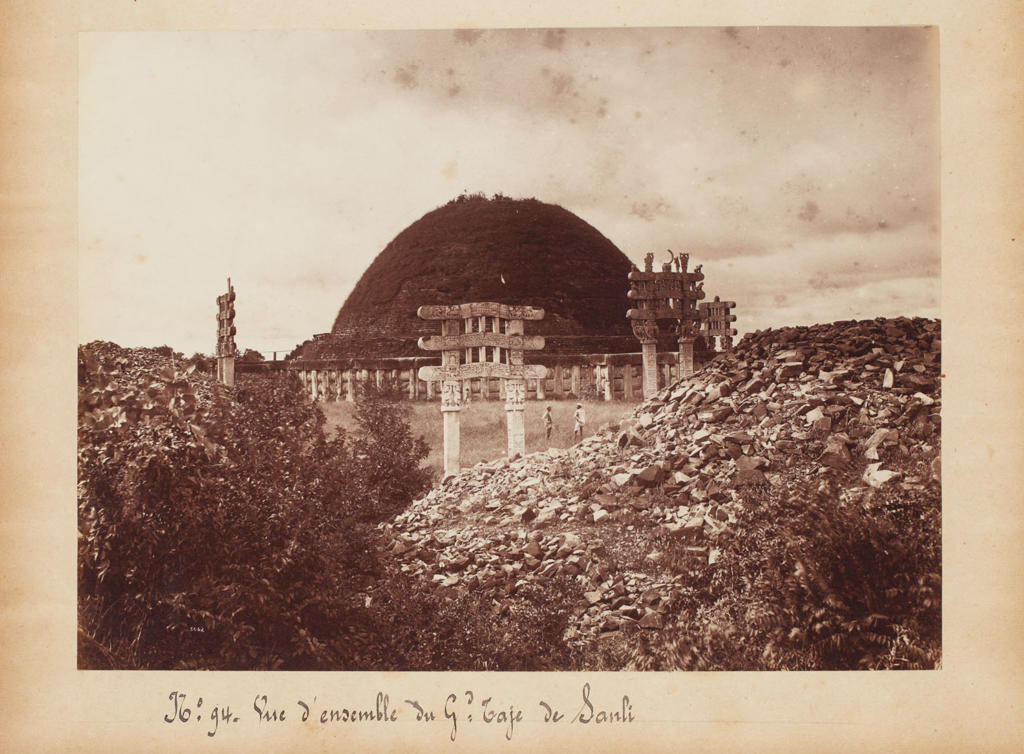
General View of Sanchi Tope, Bhopal District, Lala Deen Dayal, 1885-87 © Sarmaya Arts Foundation
The coupling of religion and empire has traditionally made for a happy marriage. Consider what the Romans did for the spread of Christianity or the Umayyad dynasty did for the eastward march of Islam. On the face of it, it seems like both parties benefited equally. With every new political conquest, the dominion of faith too would expand, finding new believers in foreign lands. But unlike empires, which are susceptible to the vagaries of human fortune, faith steps lightly with the virality of a good idea. Long after the grand temples and monasteries built by devout monarchs have crumbled into ruins, belief lives on in prayers, chants and rituals—waiting centuries to find the right listeners. We have exactly such a story of faith, empire and remarkable discovery for you, set in our own Subcontinent. It begins with the birth of a prince and culminates over two millennia later, with a most unlikely set of ragtag explorers.
In the 6th century BCE, a scion of the Shakya clan was born in Lumbini along the present-day borders of Nepal and India. Siddhartha Gautama would go on to be known as the being who achieved enlightenment, the Buddha. Shakyamuni as he was also known travelled across the Indian subcontinent, sharing his wisdom widely with anyone drawn to it. He chose to preach in vernacular dialects, attracting a huge swathe of followers who were barred by their caste status from studying Sanskrit. The Buddha’s teachings led to the quickening of a Shramanic movement that challenged the hegemony of orthodox Vedic and Brahmanical traditions. After the Shakyamuni’s death, his words and sermons were documented, preserved and studied, offering solace to people from every walk of life, from royalty to the common householder. The movement had turned into a major religion, Buddhism, which flourished throughout the corners of the country with the help of travelling orders of monks of the Sangha.
By the 12th century CE, however, we see a sharp decline in the practice of Buddhism in India and no one has been able to adequately explain why, although there are some theories. The more popular ones include the decline of urbanisation, the revival of Brahmanical traditions under the larger umbrella of Hinduism, the controversial absorption of Lord Buddha into the Hindu pantheon as an incarnation of Lord Vishnu, and invasions by foreign rulers. By the time European colonisers set foot on this land, all traces of Buddhism seem to have been lost to history. All that remained were a few broken fragments of rocks, engravings and structures, whose meanings and importance was alien to a majority of the locals.
But these ruins and rocks still had things to say. They were just waiting for the right circumstances to tell their tale. Those came about centuries later with the arrival in the 18th century of John Company, aka the East India Company. The EIC hired men from Britain and other European countries who were down on their luck and sought a career at sea. The ‘Orient’ in general and the Indian subcontinent in particular was the place to go to make their fortunes. The men—they were mainly men—came from very diverse backgrounds, both personal and professional. When they arrived in India, they brought with them a multiplicity of skill sets, educational qualifications and personal passions. These various factors played a role in developing a popular pastime of the time: unraveling the mysteries of India’s past. Luring them to the Subcontinent were real-life stories like this one:
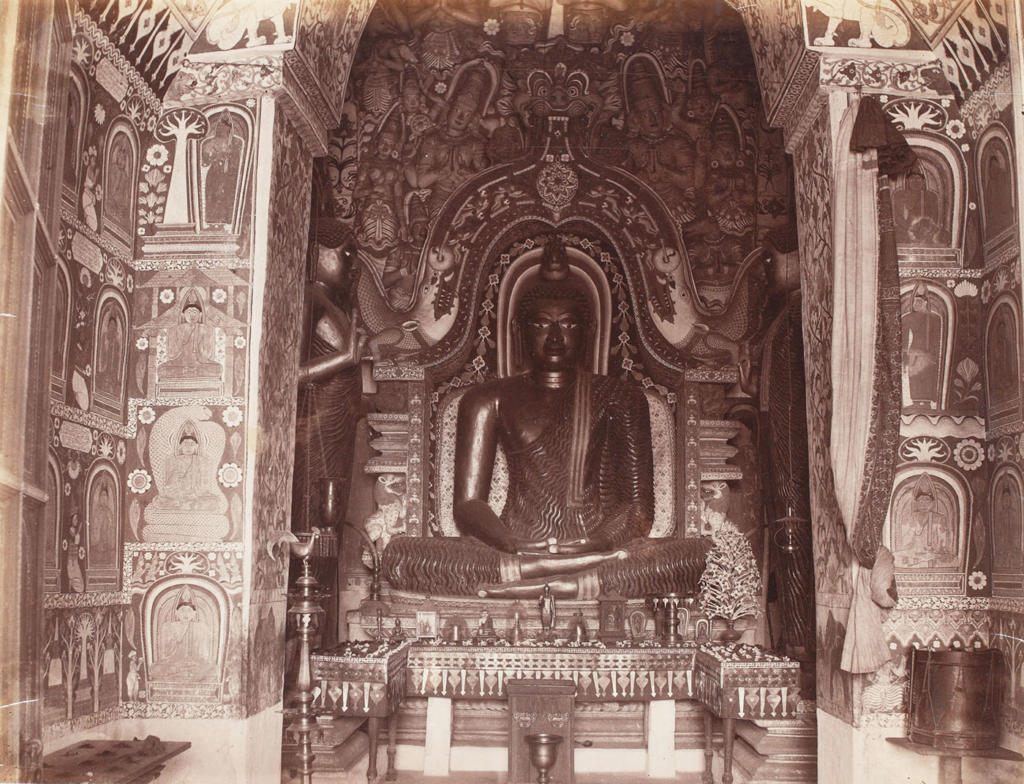
Interior of Buddhist temple, Ceylon, Unidentified Photographer © Sarmaya Arts Foundation
A storm brewed on the Madras coast, just off Fort St. George, in the November of 1659. A trading vessel called Ann slipped its anchor and drifted with the wind, coming to rest on the coast of Ceylon. Onboard was Robert Knox, a sailor. He lived an adventurous life on the island for 20 years, after which he landed in London in 1680 with a fascinating tale to tell. His account inspired Daniel Defoe’s Robinson Crusoe and threw light on the island’s religion: Buddhism. According to Knox: A ‘Buddou, who sat under a large shady tree, called Bogoha’ was being worshipped by the islanders. This was the first glimpse a Western audience ever got of the Buddha.
Oriental Jones & the Legend of Sandrokottos
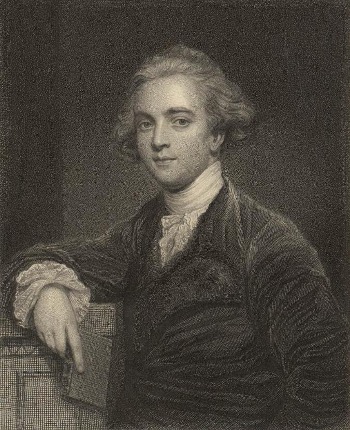
William Jones, Anglo-Welsh philologist and scholar of ancient India (1746-1794). Image courtesy the Welsh Portrait Collection at the National Library of Wales/Wikipedia Creative Commons
Among the sailors making for the ‘land of rich pagodas’ was Sir William Jones, aka Oriental or Persian Jones. A polymath fluent in over 20 languages, Jones was very curious about India, so he promptly took up a position offered to him at the Supreme Court of Bengal. In Calcutta, he founded The Asiatic Society in 1784 for the express purpose of conducting ‘Oriental research’. One of the first things he did was learn Sanskrit and start translating old texts. This enabled him to draw up a list of kings and their genealogy called the Rajavamsa. In this list, was a certain ‘law giver’ called ‘Boodha’, ‘Boodh’, or the ‘Lion of the Sacya’.
What changed the game for Jones was connecting with other kindred spirits from different parts of India. With help from EIC’s geographer and surveyor general Major James Rennell, he was able to locate the whereabouts of an ancient and erstwhile kingdom called ‘Patelpoot-her’, which had been washed away by the Ganga. From his work as a translator of Sanskrit literature, Jones knew that a king called Chandragupta once ruled the city of Pataliputra. He then made the remarkable connection between the founder of the Mauryan empire and a certain ‘Sandrokottos’ mentioned by the Greek diplomat and historian Megasthenes, who visited Chandragupta’s capital around 300 BCE.
Chandragupta Maurya is a pivotal figure in the history of our Subcontinent. His two-decade reign (some sources claim it lasted from 321 BCE to 297 BCE) brought together disparate lands and cultures across South Asia. Buddhism thrived under this Mauryan emperor and later, under his grandson, it would flourish and spread to faraway lands. While Jones slowly uncovered the buried contours of an empire and a religion, a much more significant discovery was being made by his compatriot next door in Bihar.
Dr Buchanan & the Temple of Gaya
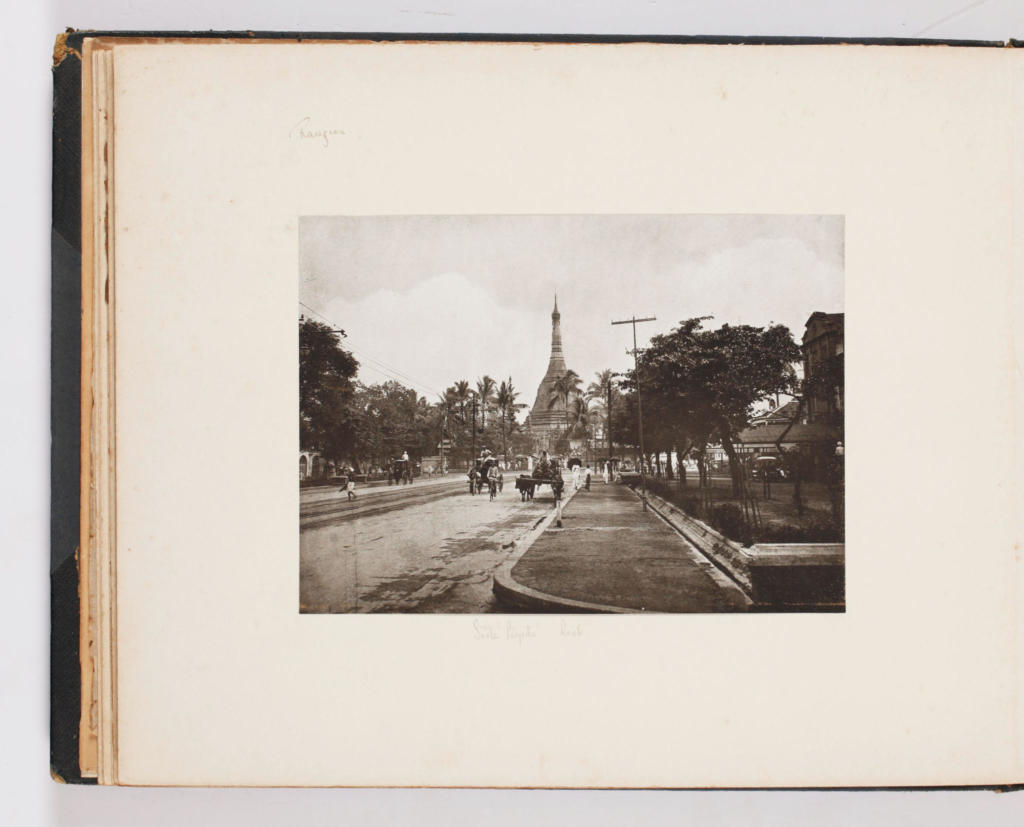
Soola Pagoda Road (Burma), Unidentified Photographer, c.1919 -1921 © Sarmaya Arts Foundation
Dr. Francis Buchanan was a botanist with a medical degree and a knack for gathering and organising varied sets of information. From 1784 to 1811, he was posted to Burma, Kathmandu and the Bengal Presidency, and he used this time to make a variety of observations on religious beliefs in these regions of the Subcontinent. He was the author of the first scholarly and serious account of Buddhism published in English with the publication of On the Religion and Literature of the Burmas in 1797. Dr Buchanan’s study confirmed three big theories about Buddhism that other researchers had also suggested: it originated in the Indian subcontinent; it was based on the teachings of a historical personality (Dr Buchanan’s work called him ‘Godama’); and as a faith, Buddhism was distinct from Hinduism.
As part of his tour of the Bengal Presidency in 1811, Dr Buchanan found his way to Gaya, then considered to be a Hindu pilgrimage site. Here he met a local Buddhist mahant or priest who showed him around the ruins of Sarnath and directed him to the Mahabodhi Temple. The mahant said he’d gleaned from Burmese travellers that the temple was built by an ‘Ashoka Dharma’.
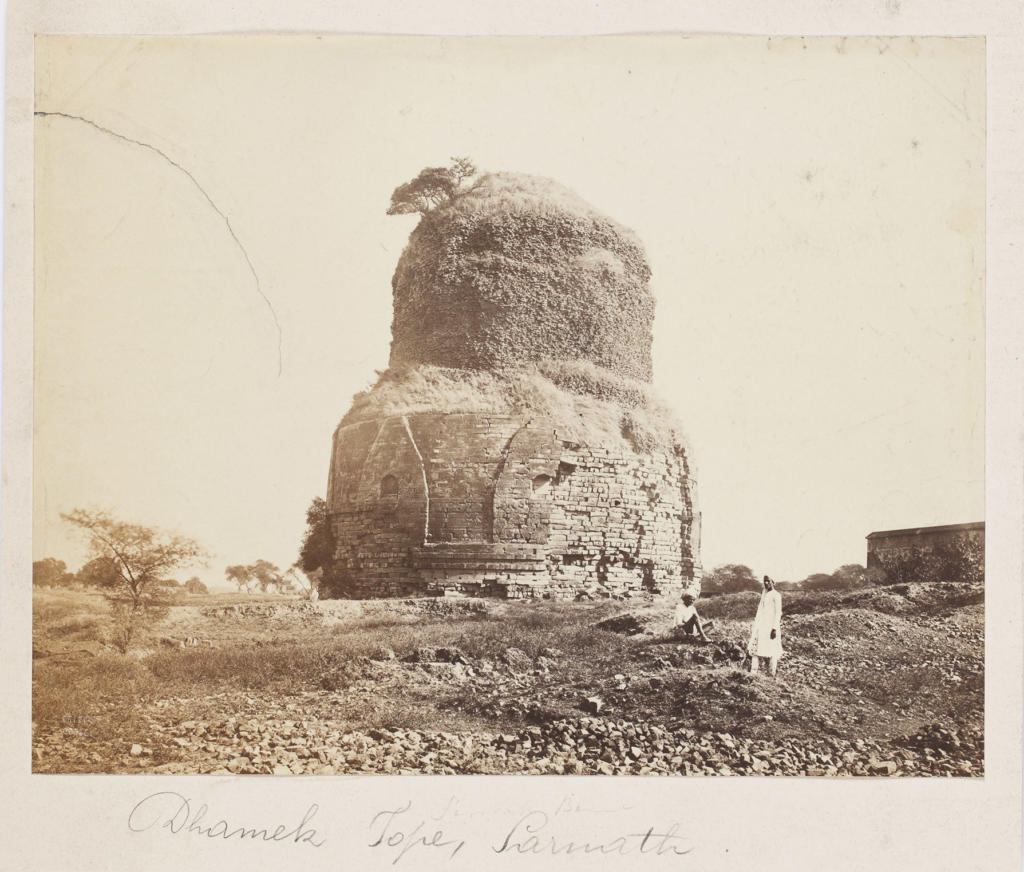
Dhamek Stupa, Sarnath. Photographed by Francis & Co. © Sarmaya Arts Foundation
Unlike the British officers hot on his trail in the 19th century, we know the identity of this king. What makes the following story extraordinary is that it shows us exactly what great historical discoveries are *not*. They are *not* the work of a single genius. They don’t happen overnight. And most importantly, they aren’t done being discovered—read on till the end to find out what we mean.
For now, let’s get back on the trail of this mysterious Ashoka.
Lt. Alexander & the Caves of Ajanta
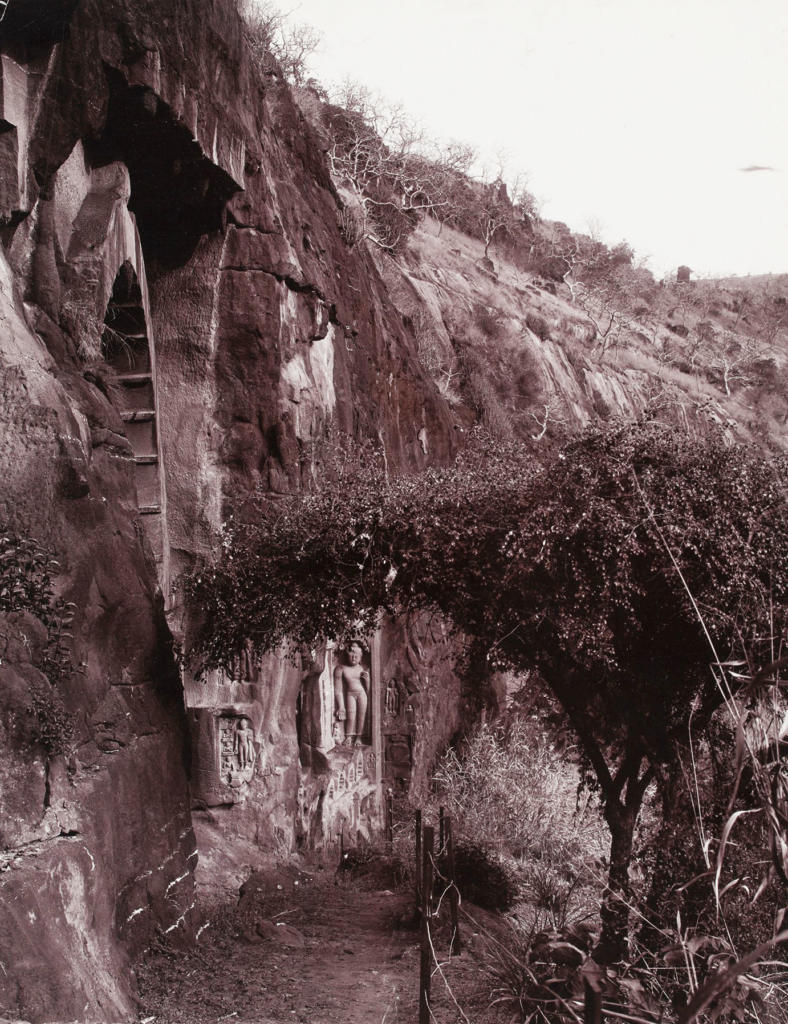
Ajanta, unidentified photographer © Sarmaya Arts Foundation
In 1824, James Alexander, a young lieutenant in the 16th Lancers took leave from his regiment and set off for a round of ‘shikar’. His destination was an unexplored region rumoured to house an ancient cave complex on the borders of the Bombay Presidency, northwest of Aurangabad. With an eye out for the tigers that roamed the area, Alexander and his party followed the Waghora river upstream and this brought them to a canyon shaped like a horseshoe. Before their eyes stood a complex of caves set high into the rockface. In his account, the lieutenant remembers being amazed by the stone images of a visage featuring “curled hair, prominent lips, and elongated earlobes”. He immediately remembered seeing something similar at Kanheri and Ellora. The only difference was that these walls were all painted, every inch of them. He was convinced that these caves served as a retirement spot for a monastic society at some point. This discovery opened a stream of visits from other curious Company men.
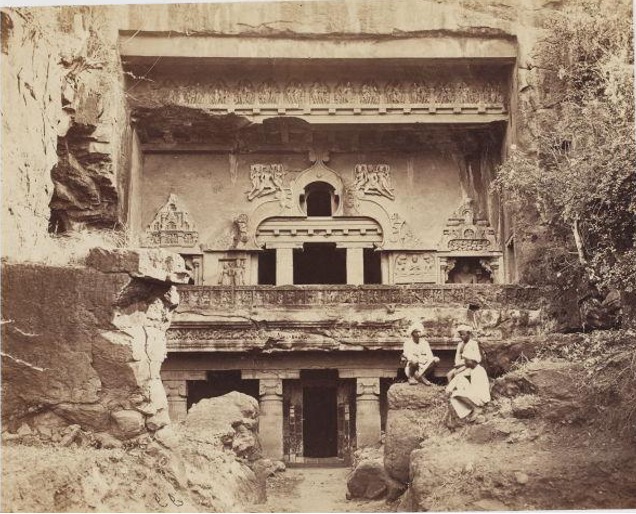
Ellora, Unidentified Photographer, 19th century © Sarmaya Arts Foundation
And the discoveries started pouring in in the form of letters, translations and archeological notes. These were received at the Asiatic Society in Calcutta as well as passed between the researchers themselves. It was a hectic and heady time to be a European scholar of Indian studies.
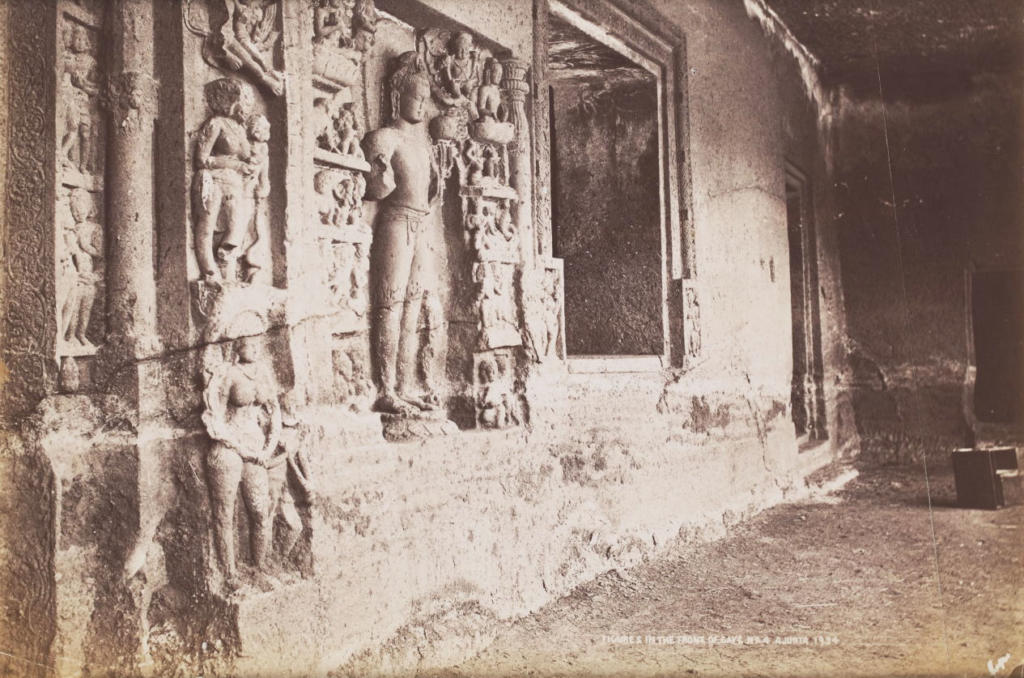
‘Figures in front of Cave No.4, Ajanta’, Unidentified Photographer, 1934 © Sarmaya Arts Foundation
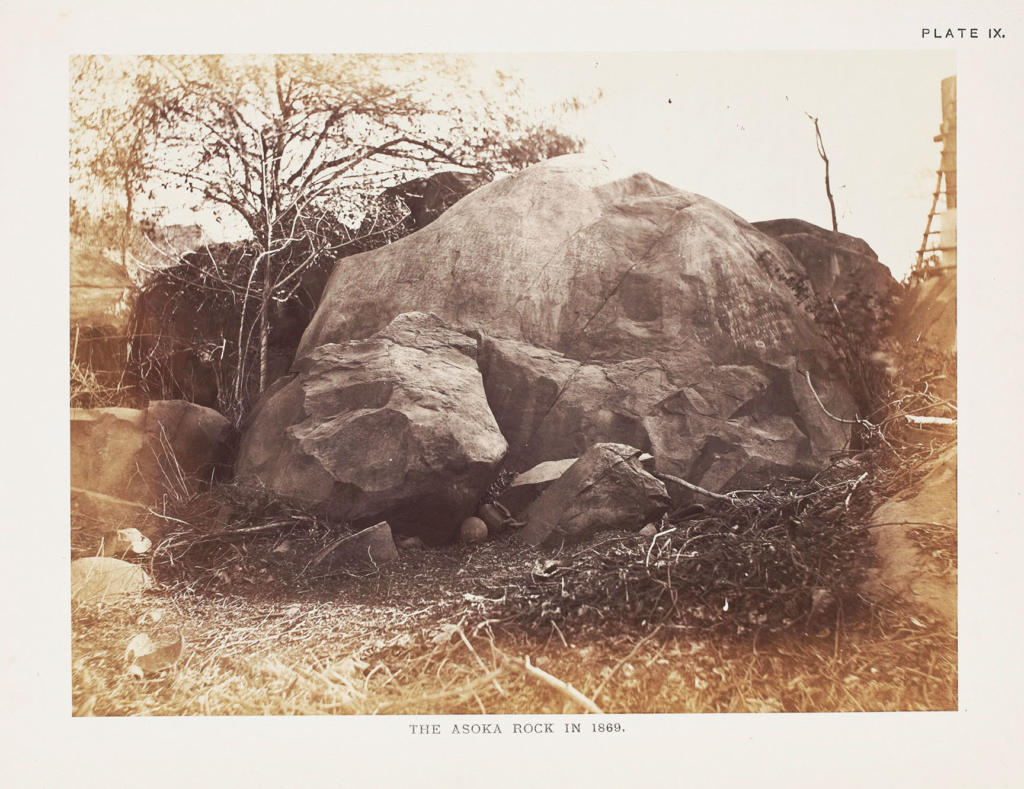
Ashoka Inscription on rock at the foot of Girnar Hill, near Junagadh, photograph by DH Sykes, 1869 © Sarmaya Arts Foundation
To illustrate the urgency and excitement of those 19th-century findings, we’ve reimagined them communicated through contemporary means.
What if these Company men had access to email? What if they could spin theories on Reddit? What if they could promote their books on Twitter? Here’s how some of the more significant findings of the time might have come to light:
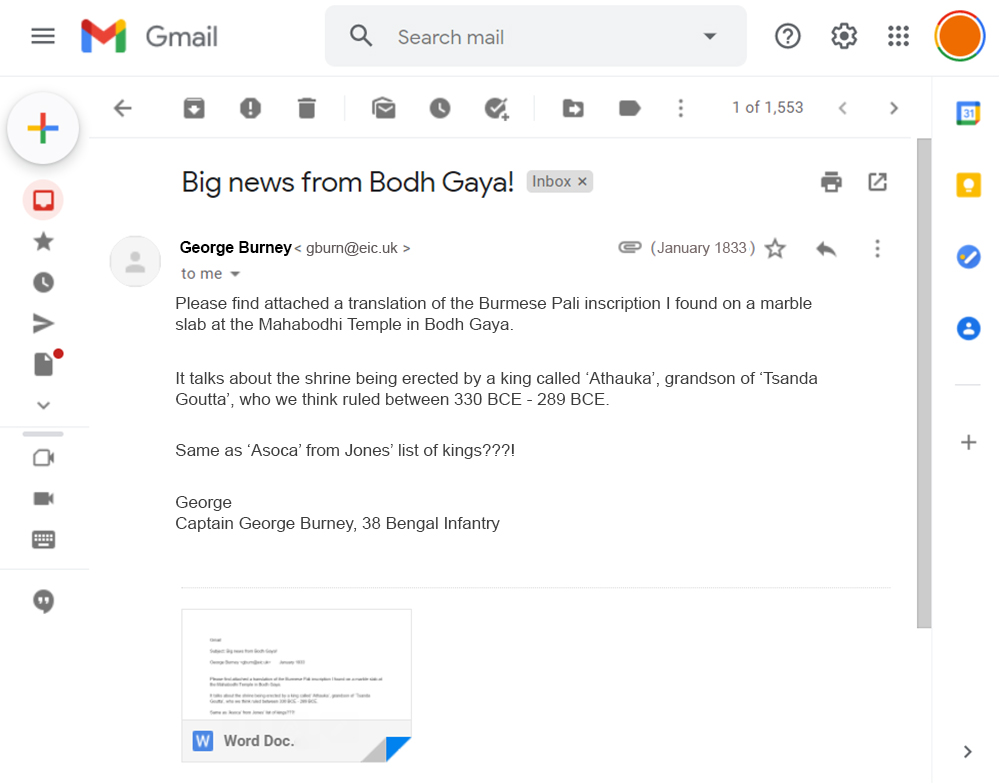
Captain George Burney’s discovery at the Mahabodhi Temple
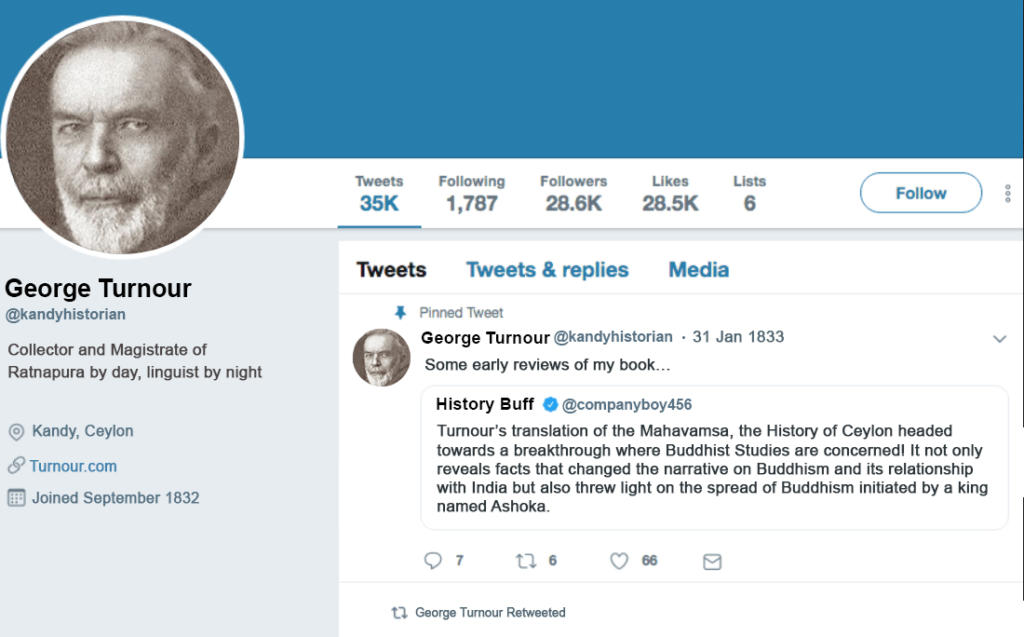
Thanks to George Turnour’s work in present-day Sri Lanka, it became clear that the history of Emperor Ashoka dovetailed with the progress of Buddhism in the Subcontinent

British scholar James Prinsep found similarities between the inscriptions on Firoz Shah’s Lat (Delhi) and the Allahabad Pillar or sthamba. Prinsep then studied the script and deciphered the inscriptions. With the help of George Turnour’s research, it was then established who the author of these royal edicts was
The Buddha & the Lost Crusades
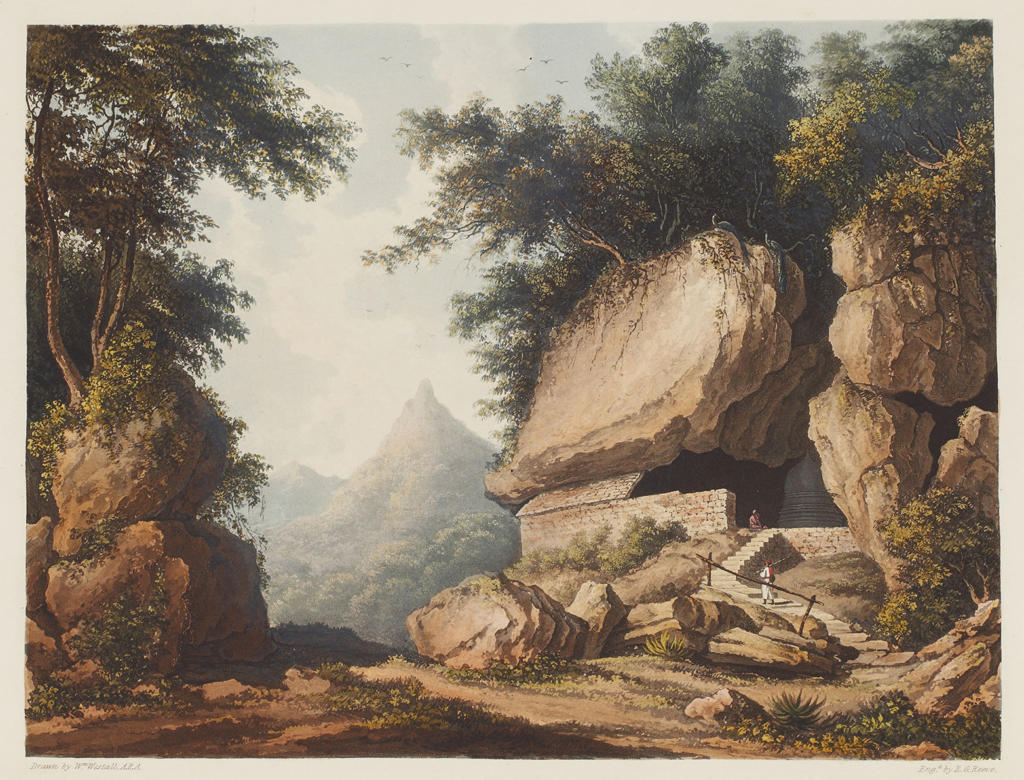
Hermitage at Kurrungalle (Ceylon), Engraving from Robert Melville Grindlay’s ‘Scenery, Costumes and Architecture chiefly on the Western Side of India’ © Sarmaya Arts Foundation
Here’s what the scholars eventually pieced together and it’s what most of us know from our school textbooks. Emperor Ashoka was the third and arguably the greatest of the Mauryan rulers, who reigned in the 3rd century BCE. Initially, he followed in the kingly tradition of war and conquests till a decisive and bloody battle at Kalinga tore at his conscience and nudged him towards the path of non-violence laid out three centuries ago by the Buddha. Ashoka committed to the three main components of Buddhism— the Buddha, the Dharma, and the Sangha—and these defined the thrust of his political administration too. He commissioned the building of numerous stupas all over India to venerate the Buddha and spread his word through edicts carved into rocks and pillars. He sent various missionaries, his own children among them, to the lands like Ceylon (present-day Sri Lanka) to share Dharma with the wider world.
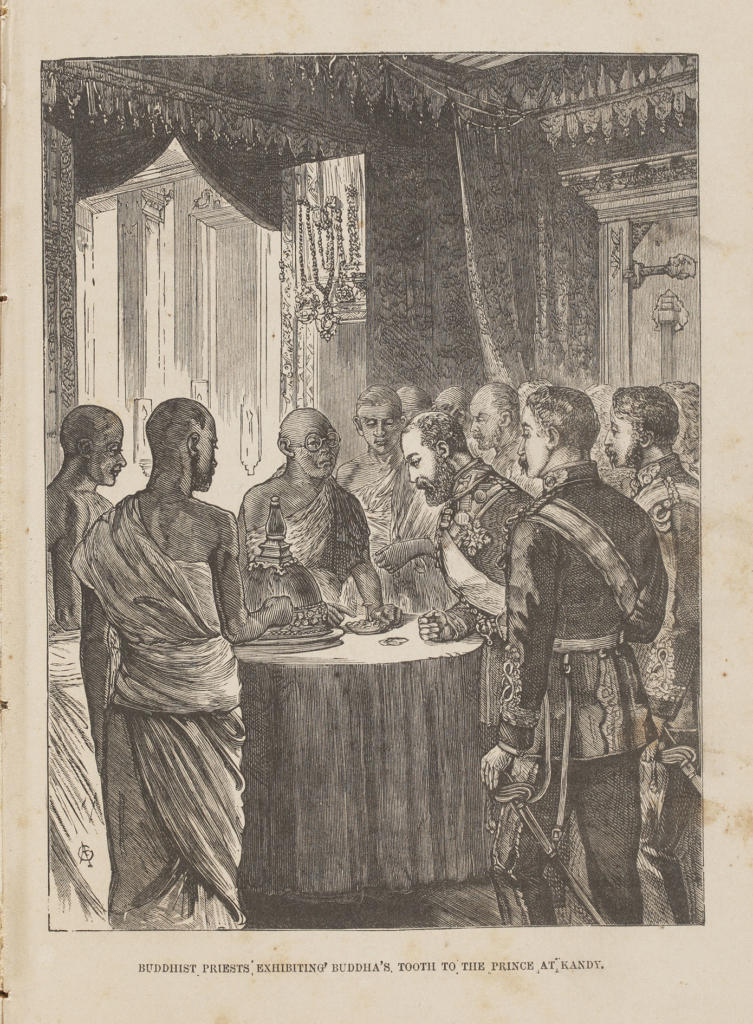
Buddhist Priests exhibiting Buddha’s tooth to the Prince of Wales, at Kandy. From the RareBook – The Prince of Wales in India, Author: J. Drew Gay, 1876 © Sarmaya Arts Foundation
While Ashoka’s reign did more than any other to help Buddhism flourish, he was by no means the only king to commit to this spiritual mission. The Kushana ruler Kanishka who ruled in the 2nd century CE was a great believer and patron of the faith. It was under Kanishka’s rule that scholars and artists first imagined into life Buddha’s physical form and his face, that serene countenance so universally recognised today. The Kushana emperor’s patronage of Buddhism helped it make inroads even further into the Asian continent and was vital in the creation of the Silk Road.
Faith took flight on the wings of trade.
The Orientalists & Everything That Followed
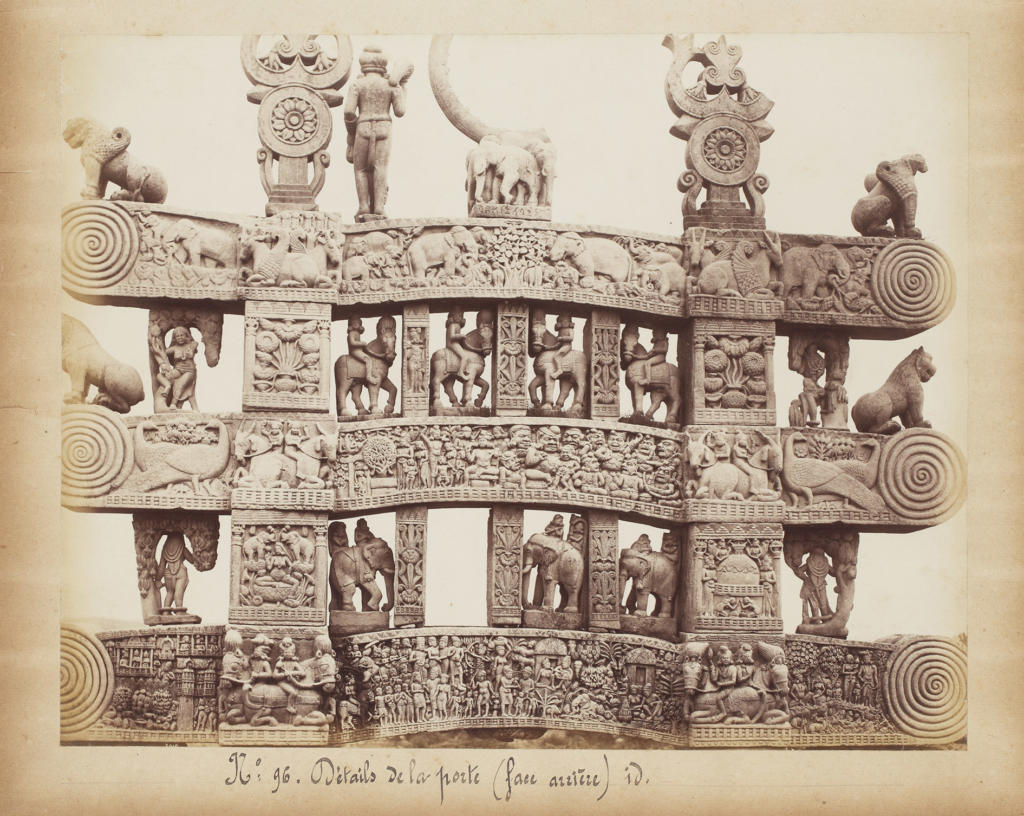
Details on the top of the Northern Gate of Sanchi Tope, Lala Deen Dayal, 1882 © Sarmaya Arts Foundation
Through the rest of the 19th-century, Europeans studying the history of Buddhism continued to make new findings. As Archaeological Surveyor to the Government of India, Alexander Cunningham set in 1861 out to trace the paths of legendary Chinese travellers to India like Fa Hien and Huang Tsang and found more lost Buddhist sites. A Hungarian named Alexander Csoma De Kőrös spent years studying the Tibetan language and translating Tibetan Buddhist scriptures, providing vital clues in the journey of Buddhism northwards. Napoleonic officer Jean-Baptiste Ventura contributed valuable research material by sending a stash of Bactrian and Kushan coins to the Asiatic Society in Calcutta.
As we mentioned earlier, it took a mind-boggling array of skills to follow this trail and many minds to bring together essential pieces of the puzzle—and they still couldn’t assemble the whole picture, only contribute incrementally to a burgeoning field of knowledge. Researchers had to know languages including Pali, Sanskrit, Sinhalese, Tibetan, Greek and Aramaic, and have the ability to read scripts including Brahmi and Kharosthi. Numismatics, archeology, oral histories, literature, architecture and art, all held keys to a part of the narrative. Being officers of the powerful East India Company gave these seekers free rein over the breadth of the Subcontinent and the Empire’s growing political influence created a network that made research collaboration possible across far-flung geographies.
But the very fact of their identity as colonisers tainted their study. The moniker by which they were known—Orientalists—was a limited and limiting one. It exoticised the subjects of their gaze instead of humanising them. Then there was the matter of sources. By the time the British arrived in the Subcontinent, Buddhism had disappeared from mainstream discourse so officers would turn to less credible informants. George Turnour, in his introduction to the translation of Mahavamsa, writes that the European scholars by the end of the 18th century consulted only with Hindu pandits due to the absence and ‘expulsion’ of Buddhist entities from India—the same pandits who declared the worship of the Buddha to be heretical.
Victorian virtues and ideals too played an insidious role. The Europeans, so well versed in the western Classical myths and sources, couldn’t help but use ‘etymological techniques’ to compare their Christian beliefs and Classical characters to Buddhist features. Dr Buchanan compared Buddha to Noah, while Cunningham compared him to Hermes, and Jones to Sesac of Egypt using the same techniques. Some even denied outright the fact of the Buddha’s existence, refusing to consider the possibility that humankind could ever worship one man for so long.
But as the study of Buddhism progressed, it slipped the narrower grasp of the colonial mind and came to be embraced more holistically by Indian scholars of the 19th and 20th century. Our understanding was enhanced by the work of such stalwarts as Rajendra Lal Mitra, the first Indian President of the Asiatic Society in 1885, and Buddhist scholar and monk Acharya Dharmananda Damodar Kosambi. Not to mention, Dr B R Ambedkar, who founded a new ideology called Navayana Buddhism, which offered an egalitarian form of spirituality to the multitude of Indians oppressed by the Hindu caste system.
Even in the 21st century, the empire of the Buddha continues to conquer new lands in our imagination. Every so often a new discovery tells us something fresh and startling about the movement and its royal patrons. Earlier in 2021, we learned of a Buddhist monastery on top of a hill in Bihar that was run by a woman and patronised by Mallika Devi, wife of King Shurapala of the Pala dynasty. The Pala rule ended in the 12th century and it wasn’t her marriage to one of its kings that ensured this queen’s legacy. It was a far more enduring alliance with faith that bestowed her with immortality. Empires may come and empires may go. But belief lingers and its reign is supreme.
References
- Ashoka by Charles Allen
- Buddha and the Sahibs by Charles Allen
- A Record Of Buddhistic Kingdoms Being An Account By The Chinese Monk Fa-Hien Of His Travels In India And Ceylon (A.D. 399-414): In Search Of The Buddhist Books Of Discipline
- Mahabodhi: The Great Buddhist Temple by Alexander Cunningham
- Studies in History of Buddhism by A K Narain
- The British Discovery of Buddhism by Philip C. Almond
- MARG: A Magazine of the Arts Vol. 9
- India by John Keay
- Translating the Buddha: Edwin Arnold’s Light of Asia and Its Indian Publics by Douglas Ober



